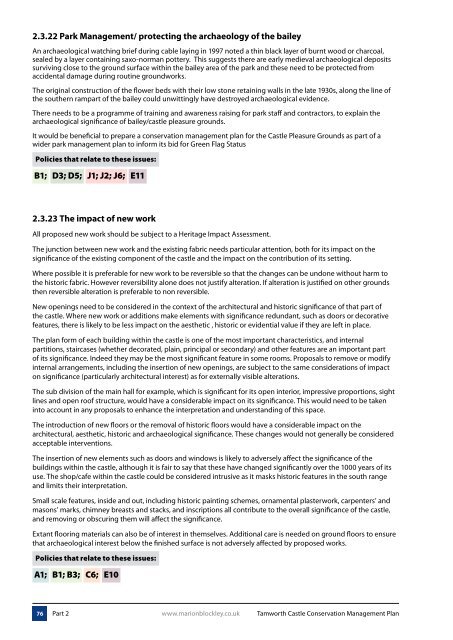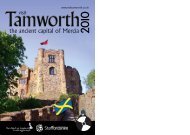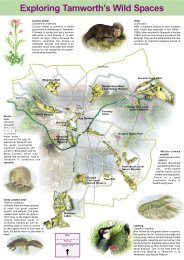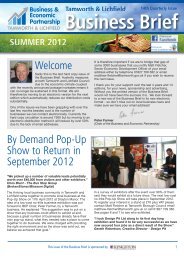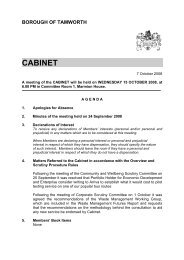Conservation Management Plan - Tamworth Borough Council
Conservation Management Plan - Tamworth Borough Council
Conservation Management Plan - Tamworth Borough Council
You also want an ePaper? Increase the reach of your titles
YUMPU automatically turns print PDFs into web optimized ePapers that Google loves.
2.3.22 Park <strong>Management</strong>/ protecting the archaeology of the bailey<br />
An archaeological watching brief during cable laying in 1997 noted a thin black layer of burnt wood or charcoal,<br />
sealed by a layer containing saxo-norman pottery. This suggests there are early medieval archaeological deposits<br />
surviving close to the ground surface within the bailey area of the park and these need to be protected from<br />
accidental damage during routine groundworks.<br />
The original construction of the flower beds with their low stone retaining walls in the late 1930s, along the line of<br />
the southern rampart of the bailey could unwittingly have destroyed archaeological evidence.<br />
There needs to be a programme of training and awareness raising for park staff and contractors, to explain the<br />
archaeological significance of bailey/castle pleasure grounds.<br />
It would be beneficial to prepare a conservation management plan for the Castle Pleasure Grounds as part of a<br />
wider park management plan to inform its bid for Green Flag Status<br />
Policies that relate to these issues:<br />
B1; D3; D5; J1; J2; J6; E11<br />
2.3.23 The impact of new work<br />
All proposed new work should be subject to a Heritage Impact Assessment.<br />
The junction between new work and the existing fabric needs particular attention, both for its impact on the<br />
significance of the existing component of the castle and the impact on the contribution of its setting.<br />
Where possible it is preferable for new work to be reversible so that the changes can be undone without harm to<br />
the historic fabric. However reversibility alone does not justify alteration. If alteration is justified on other grounds<br />
then reversible alteration is preferable to non reversible.<br />
New openings need to be considered in the context of the architectural and historic significance of that part of<br />
the castle. Where new work or additions make elements with significance redundant, such as doors or decorative<br />
features, there is likely to be less impact on the aesthetic , historic or evidential value if they are left in place.<br />
The plan form of each building within the castle is one of the most important characteristics, and internal<br />
partitions, staircases (whether decorated, plain, principal or secondary) and other features are an important part<br />
of its significance. Indeed they may be the most significant feature in some rooms. Proposals to remove or modify<br />
internal arrangements, including the insertion of new openings, are subject to the same considerations of impact<br />
on significance (particularly architectural interest) as for externally visible alterations.<br />
The sub division of the main hall for example, which is significant for its open interior, impressive proportions, sight<br />
lines and open roof structure, would have a considerable impact on its significance. This would need to be taken<br />
into account in any proposals to enhance the interpretation and understanding of this space.<br />
The introduction of new floors or the removal of historic floors would have a considerable impact on the<br />
architectural, aesthetic, historic and archaeological significance. These changes would not generally be considered<br />
acceptable interventions.<br />
The insertion of new elements such as doors and windows is likely to adversely affect the significance of the<br />
buildings within the castle, although it is fair to say that these have changed significantly over the 1000 years of its<br />
use. The shop/cafe within the castle could be considered intrusive as it masks historic features in the south range<br />
and limits their interpretation.<br />
Small scale features, inside and out, including historic painting schemes, ornamental plasterwork, carpenters’ and<br />
masons’ marks, chimney breasts and stacks, and inscriptions all contribute to the overall significance of the castle,<br />
and removing or obscuring them will affect the significance.<br />
Extant flooring materials can also be of interest in themselves. Additional care is needed on ground floors to ensure<br />
that archaeological interest below the finished surface is not adversely affected by proposed works.<br />
Policies that relate to these issues:<br />
A1; B1; B3; C6; E10<br />
76 Part 2 www.marionblockley.co.uk <strong>Tamworth</strong> Castle <strong>Conservation</strong> <strong>Management</strong> <strong>Plan</strong>


